Materials
- images of umbrellas of different colors
- scissors (adult use only)
- white construction paper
- markers of various colors
- laminator (optional)
Preparation
- Cut out (or draw) and attach to construction paper images of umbrellas of various colors. Print the names of the colors on separate pieces of construction paper. Note: It is best to write the names of the colors in those colors.
- Laminate both the image and word cards for durability.
What To Do
1. On a rainy day in spring, gather the children together and discuss the weather. Ask if any of the children used umbrellas on their way to the class that day. Explain that the springtime is often rainy.
2. Show the children the images of umbrellas, and talk about the different colors.
3. Show the children the matching word cards. Spell out the names of the colors for the children.
4. Challenge the children to match the word cards to the umbrella cards by color. Also challenge the children to spell the names of the colors.
Assessment
To assess the children's learning, consider the following:
- Can the children identify the colors of the umbrellas by name?
- Can the children match the umbrella cards to the color-name cards?
- Can the children spell the names of the colors?
-Jackie Wright, Enid, OK
Instructions
l Fill clean condiment squeeze bottles with clean water.
What To Do
1. Talk with the children about what they do during the summer. Ask the
children if they have ever been to the beach during the summer.
2. Ask the children to gather around the sand table. Talk about how people at
the beach in the summertime often play with sand.
3. Show the children how to carefully dribble water on dry sand to moisten it,
pack the wet sand into a plastic cup or seashell, and turn it over to make a
standing structure.
4. As the children play and explore, encourage them to feel the textures of wet
and dry sand, as well as the hard and smooth or rough and bumpy textures of
the seashells and sea objects.
5. Call attention to the difference between wet and dry sand textures. Point
out to the children how dribbling water on dry sand changes the texture and
makes it easier to pack.
6. Encourage experimentation. Challenge the children to make a seashell stick to
the side of a sand structure, or to try stacking one structure on top of another.
Teacher - to - Teacher Tip
l Include some math in this activity by counting the cups full of wet sand the
children use to make their structures or how many seashells they include in a
design.
Assessment
To assess the children's learning, consider the following:
l Do the children build structures with sand and water?
l Do the children comment on the texture of the sand and shells?
